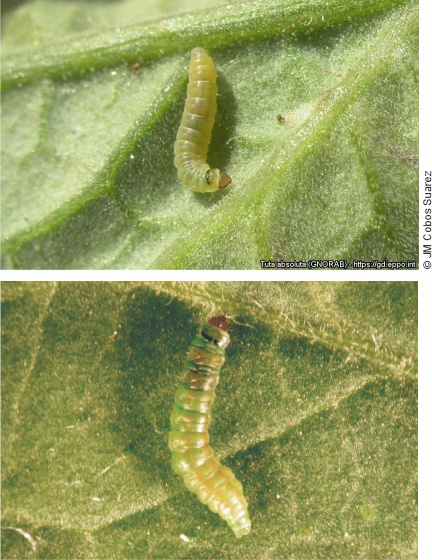Morphology and biology
Egg: It is creamy white, sometimes yellow, turning a darker shade when close to hatching. It is cylindrical with an average length of 0.36 mm and width of 0.22 mm.
The eggs are individually laid and rarely, they can be found in groups of 5, preferably on the underside of young or fairly mature leaves (Notz, 1992). The average duration before hatching is 4.5 days at a temperature of 24.6
oC.
Larva: The prothoracic shield has a dark stripe on its backside. The newly hatched larva is creamy yellow to later turn a greenish colour. Its size varies from 0.9 mm at the beginning to 7.5 mm at the end of
its growth period.
Once the larva emerges, it starts walking and finds its penetration point. It then breaks the epidermis and penetrates into the leaf, consuming the mesophyll. The larva can abandon the mine at any given moment and build another
one on a nearby leaf. They can spread very quickly to other plants by hanging on silk threads and then being transported by the wind. The average growth period lasts 12.01 days, therefore they need to go through 4 stages.
Tuta absoluta larva inside a tomato stem
Pupa: Newly formed it is green, turning a dark brown colour when the adult is about to emerge. The female pupa is larger than the male pupa, measuring 4.67 mm and 4.27 mm long and 1.37 mm and 1.23 mm wide,
respectively. Larvae that are ready to pupate, stop feeding and begin to spin a cocoon.
This can happen in the leaves, inside the mines, on the ground or in the fallen leaves. The average growth period for male pupae is 7.80 days and for female pupae 6.72 days.
Adult: Both sexes have ashen forewings with shades that vary from blackish to grey. The hindwings are a bright black colour with dark cilia. The head, thorax and palps are ash grey with dark shades. The length
of the forewings is from 4.5 to 4.7 mm.
They are nocturnal, remaining hidden amongst the leaves during the day. When they are annoyed, they begin an erratic and short flight. Copulation starts immediately after the adult emergence.
Fertility is high with an average of 241 eggs per female and a fertility rate of almost 100%. The vast majority of eggs are laid during the first 10 days at the beginning of oviposition. Life expectancy for males is 27 days
and for females is 24 days.
Damages
The larvae attack the fruits and the leaves by entering inside them and feeding on the mesophyll. This produces the typical damage of a leaf miner and consequently, they wither. When the attacks are severe, the damaged leaves
look burnt, which could be confused with disease.
The damage produced by Tuta absoluta to tomatoes, aubergines and potatoes causes a devastating effect on the economy.
Damage to tomato plants caused by Tuta absoluta
Damage to ripe tomatoes caused Tuta absoluta































